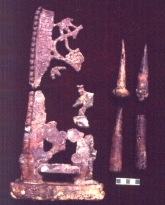
Bronze Standard and Splicing Tools from, Shiqmona
The remains of fishing equipment and many cargoes of wrecked ships were found throughout in the area of the North Bay. Stone anchors of various types were recovered, including a Byblos type anchor dated to the MB, several groups of one-holed stone anchors, probably dated to the LB, and twenty three-holed anchors which are attributed to the Iron Age, Persian and Medieval Periods. A few Persian Period assemblages included broken stone jars with basket handles and the lead cores of wooden anchors. In addition, bronze furniture parts, horse bridles, duck-shaped weights and lioness-shaped jar-handles were recovered. Three assemblages containing bronze and silver Ptolemaic coins, various bronze objects and a lead missile bearing a decorative lizard, are attributed to the Hellenistic period. A few lead balance weights bearing Greek inscriptions, a bronze oil lamp and a relief of a ship’s prow were also recovered. One of the Hellenistic assemblages may have belonged to the vessel that carried the bronze battering ram (see below).
A group of bronze objects joined together by a concretion were dated to the Byzantine period. The hoard contained a bronze socketed standard decorated with a trellis of vine tendrils and bunches of grapes on both sides. The standard is also decorated with an engraved seven branched ‘Menorah’, a ram’s horn (‘Shofar’), a palm branch (‘Lulav’), and an inscription mentioning the Talmudic city of Shiqmona. This assemblage also contained a bronze figurine of a woman carrying flowers, and four wooden spikes used for splicing ropes (almost identical wooden spikes are used today by fishermen and seamen). A Mameluke-Ottoman shipwreck from the 16th century included four bronze swivel-bow cannons and a bronze bombard (weighing 2,200 kg and 3.25 m long), fourteen stone cannon balls (diameter 30 cm) and twenty bronze helmets. A two-armed admiralty anchor with traces of its wooden stock and two large grapnel anchors were also found.
A cluster of ribbed stone columns, (height c. 2 m) with a square base and a perforation in the upper part were found east of the harbor at the foot of the north end of the ruined Crusader’s city-wall. Rows of wooden poles stuck upright into the sea floor were found in several concentrations next to the coastline, east of the ancient harbor. The poles were dated by C14 to the Crusader Period. Chains or wooden rods may have been threaded through the perforations. The columns, together with the wooden poles, may have formed part of a barrier built in shallow water intended to prevent enemy forces from approaching the fortress walls from the northeast. Alternatively, the stone columns and the wooden poles may represent the remains of a jetty, a quay or some other mooring installation.